The Cornell Lab Bird Academy › Discussion Groups › Nature Journaling and Field Sketching › Getting Comfortable with Watercolor
-
I am familiar with wet on dry and wet on wet. I tried both techniques and the key issue is control of the water, especially letting it dry before adding anything next to it or the colour will run. It is very unforgiving, especially wet on wet. Using a dry brush was a new technique (I have only done this accidentally in the past) and gives a useful effect, which may be useful for bark etc.
-
This was very informative. Still having a hard time with dry on dry, but it gave me a better idea of how to handle the medium and what technique works best in different scenarios.
-
I applied all the techniques to get the feel of them. I'm familiar with them, yet i discovered that dry brushing techniques add texture to rough surface. Adding color and sweeping the edges is a technique I would like to share because it helps define the edges and give the shape a nice tidy look. For future journaling, I feel much more confident to apply the glazes over added color to mute it down. Following the drawings shared, they helped to implement the techniques and compare with the drawings. Thank you. Below are the practice drawings I did. It took a long time, but was fun.



-
I tested out all of these techniques. I can see that the wet on wet would be great for backgrounds, but it's kind of unforgiving. I wonder if it dried, if I could do a wet on dry over it. I am going to need more practice to master the texture of dry on dry with a water brush. In the future, I will try the wet on dry for detail work and dry on wet for large areas of color.
-
I have tried all three techniques. Wet on dry offers more options for control . It is direct painting. You make your mark in the spot where you want it to be. You have to pay more attention to what is happening with wet on wet because the colors can mix or go in direction that you might not want them to go. It can be challenging. I really like the textured look that you can achieve with dry brush on dry paper. For instance you can make a field of grass without making a brush stroke for each blade of grass.
-
I'm having fun blending colors. I was glad to learn the 3 techniques today as that will give me more control over my brush.
-
 I enjoyed this! I love seeing the Canada Geese at a park on a river where I live. This little painting is from one of my photos. I took some artistic liberties with colors. I decided to give everything a bluer, cooler tint - so I started with a blue tone to the white on the goose to take the edge off the ivory toned watercolor paper. Then, I added blue to the black for the head & neck and blue to a dark cool brown for the body. I decided to use the same Ultramarine Blue in the water as well, which was actually a Cerulean Blue in the photo. I neutralized the Ultramarine Blue with a yellowish orange so the water would recede and the goose would be more of the focus. For all this I worked wet on dry, but I wasn't sure if that was right - maybe I should have wet down the paper first for the water. There are some slightly mottled areas, but I got lucky and they look a little like ripples in the water (LOL). I worked wet on wet for the goose's reflection in the water, but then it wasn't dark enough, so I worked dry brush over it to create dark ripples in the water. It unfortunately lost some of the luminosity from wet on wet as a result, but I think it still looks somewhat like a reflection.
I enjoyed this! I love seeing the Canada Geese at a park on a river where I live. This little painting is from one of my photos. I took some artistic liberties with colors. I decided to give everything a bluer, cooler tint - so I started with a blue tone to the white on the goose to take the edge off the ivory toned watercolor paper. Then, I added blue to the black for the head & neck and blue to a dark cool brown for the body. I decided to use the same Ultramarine Blue in the water as well, which was actually a Cerulean Blue in the photo. I neutralized the Ultramarine Blue with a yellowish orange so the water would recede and the goose would be more of the focus. For all this I worked wet on dry, but I wasn't sure if that was right - maybe I should have wet down the paper first for the water. There are some slightly mottled areas, but I got lucky and they look a little like ripples in the water (LOL). I worked wet on wet for the goose's reflection in the water, but then it wasn't dark enough, so I worked dry brush over it to create dark ripples in the water. It unfortunately lost some of the luminosity from wet on wet as a result, but I think it still looks somewhat like a reflection. -
It is beautiful. It would be interesting to see it with the water done wet on wet.
-
-
Fun! I'm having some trouble with the dry brush technique, the brush really does retain a lot of water. There is a lot of waiting involved in many of these which requires some getting used to, but the watercolor is really fun and rewarding when you get it right!
-
I had difficulty with mixing the colors. The watercolor technique which was the most familiar and, therefore, seemed the easiest was the "wet on dry". I practiced with varied wetness of the brush and was able to see the changes in color when a new color was added. But, I will need a lot of practice not to over the brush. The wet on wet was "awash out" literally and figuratively. It was most difficult to use when mixing colors. As for the "dryon dry", it was quickly apparent how texture could be developed in a picture. Do you use all 3 in a painting?
-
I did the same painting using the three different techniques and for this one I think the wet on wet turned out best, but in general for nature journaling I prefer the wet on dry. I still have to work on the dry on dry technique.
 Really fun activity!
Really fun activity! -
I had most success with wet on dry and layering, requiring dry time. Can the mixed paints sit in the pallette for a day or so? Seems difficult to recreate the same color mixes. I feel that my wet on wet and dry on dry skills need more practice. I would like make better impressions of
 snow, water, and sky using wet on wet.
snow, water, and sky using wet on wet. -
I have been trying to make a xmas card recently and have used both wet on wet and dry brush. I like both techniques and have always used them in the past. Wet on wet is hard in that you have to have the paper just wet the right amount or it becomes dry before you want it to. With dry brush or dry brush on wet, if you make a mistake you can't correct it. I enjoyed wet on wet copying the Mallard, its fun to see how it works. You can't go too wrong as there are no hard lines. I find that if I just use a wet brush on dry my photo is a bit messy looking. It's harder to make it look natural.



-
I was working on this Junco for a xmas card and used both wet on wet and dry brush techniques. I like using both together. When I just use dry brush, it tends to get messy looking. See the example of the garden scene. Wet on wet isn't easy either because if the paper dries and you don't notice, the paint forms a hard edge where you don't want it to. I enjoyed working on the mallard using wet on wet. I like doing flowers wet on wet too.



-
This is very relaxing. I enjoyed it. I do have to be careful not to be distracted and get paint outside of the outline. I like the wet-on-wet and the wet-on-dry techniques. I think it will help with my rough sketches.

-

-
 This is what I did to try out the different techniques. Very difficult to regulate the amount of water on the brush. Took a while to get the hang of it. Still need practice but feel a little better about it
This is what I did to try out the different techniques. Very difficult to regulate the amount of water on the brush. Took a while to get the hang of it. Still need practice but feel a little better about it -
<p style="text-align: left;">I have used acrylics to paint birds but have never used water color. I found water color much more difficult. I tend to over paint trying to get everything perfect and therefore the paper got beaded. I could not get a bright yellow. I tried adding white but it just lightened the yellow. Does anyone have any ideas for me. I used dry on wet for the bird along with some dry on dry trying to get a feather effect. I used wet on wet for the back ground. Here I had to keep mixing the colors because I would run out of paint and could not get the same color again. I will keep practicing. I love to paint.
 </p>
</p> -
I appreciate your Western Tanager just like it is. The yellow color is very pleasing to my eyesight and brings out a feeling of cheerfulness as the tanager opposes gravity.
-
-
 I used the wet on dry technique on the bird and many paint layers. I tried the wet on wet technique on the sky and grass but it is very difficult.
I used the wet on dry technique on the bird and many paint layers. I tried the wet on wet technique on the sky and grass but it is very difficult. -
I find the end effect very beautiful!
-
I love it, too!
-
A very appealing portrait of a bird with a very long and unusual tail which reminds me of an Australian beekeeper bird.
-
-
Used wet on dry on the Jay
 and then wet on wet with the golden light behind.
Also I layered many various colors in the feathers, especially back of neck area.
and then wet on wet with the golden light behind.
Also I layered many various colors in the feathers, especially back of neck area. -
I tried all three techniques. I was interested in how far I could push the brush and paper with these techniques. I did three small painting using only one technique at a time. Wet on wet is very loose, can be a little out of control, and I had to let the paper dry between areas when I did not want the paint to blend. Also found that if I did a large painting the paper buckled a bit. Wet on dry was the easiest way to paint with the sketch book and the nylon brushes. I personally love dry brush but found it difficult because the amount of water on the brush or wet paint on the picture resulted in a combo. Next I decided to use all three on one painting. Had a false start as the watercolor paper was hard to get wet enough with the nylon brushes, it began to form little particles of loose paper from rubbing the surface. I then started over using 140 lb. paper and was afraid I would ruin the nylon brushes so I switched to real watercolor brushes to complete the same picture. My conclusion is to use the nylon brushes in the field for quick sketches and perhaps when creating a journal page. This is an excellent match of all the tools. However, if I want to create artwork to frame in a larger format, I will stick to the heavy paper and natural hair brushes. I really like the palette and the transparency of these colors. Also it pleases me that it is possible to incorporate these techniques into the journal. Since most of the paintings will be on a smaller scale, it is always good to know it is possible to use whatever is needed to complete the sketch. Pat


-
I’m still getting used to water color in general: like not using too much water etc... However, this lesson was very cool. I experimented with all three and attempted to use them in a picture. I found that the techniques fit in exactly how Liz said they would. Wet on dry for detail, wet on wet for large spaces, and dry brush for rough surfaces. The proportions are way off, but I was not really focusing on them for this exercise.


-
I haven't finished my toucan yet, but I am using the different techniques in it.

-
Woah! That’s amazing!
-
I can't believe you are using water color on this! 'How many layers have you done for this effect?
-
Beautiful
-
-


 I have tried all 3 techniques. Dry brush as you can see on the abalone seem to come off to harsh or too bold. I found patience is key and waiting for the paint to dry before muddling up the painting. I love water and lightness of pigment in creating skies.
I have tried all 3 techniques. Dry brush as you can see on the abalone seem to come off to harsh or too bold. I found patience is key and waiting for the paint to dry before muddling up the painting. I love water and lightness of pigment in creating skies. -
Like how you played with the color and line I’m smaller images
-
-
 The sky, water, and trees were first wet on wet with some wet brush on top once the paper had dried. The fence was from a dry brush. The grass was wet on dry.
The sky, water, and trees were first wet on wet with some wet brush on top once the paper had dried. The fence was from a dry brush. The grass was wet on dry. -
I had previously tried only wet on dry. I thought wet on wet was the most interesting. I need much more experience with each to learn what works and what doesn’t and how I could use them in my journals.
Read More:
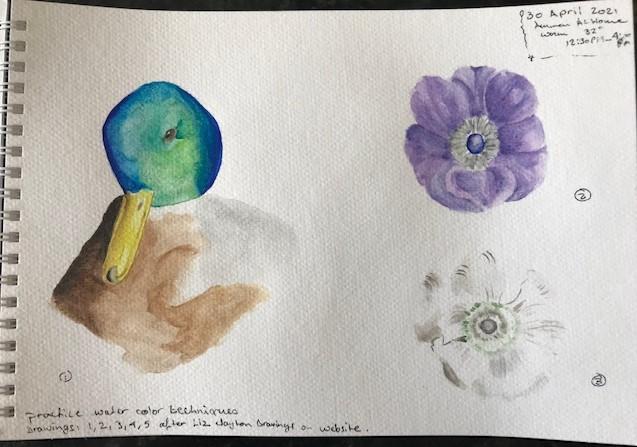
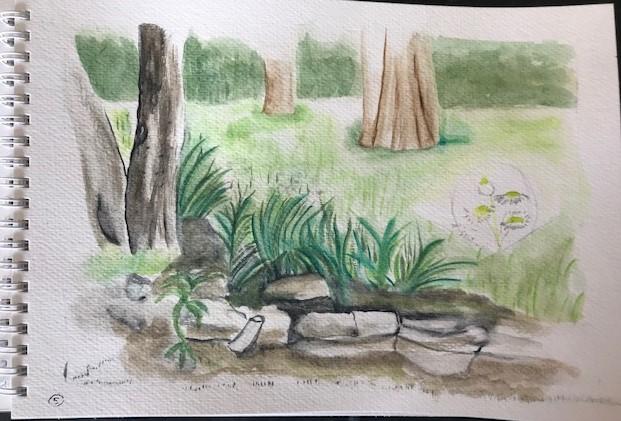
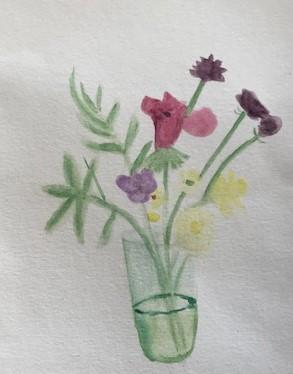
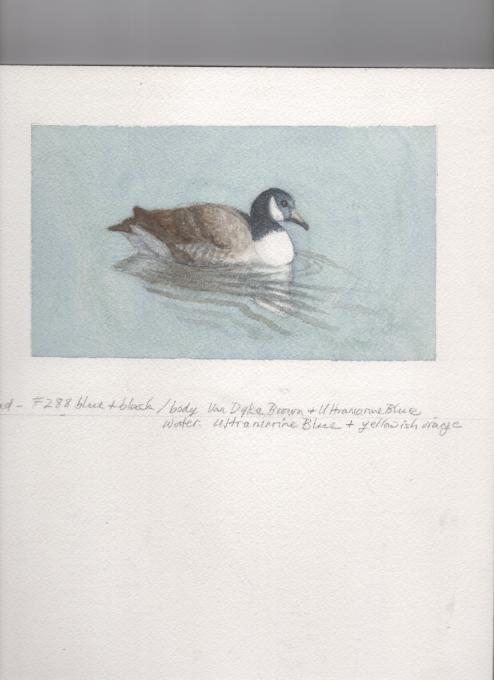 I enjoyed this! I love seeing the Canada Geese at a park on a river where I live. This little painting is from one of my photos. I took some artistic liberties with colors. I decided to give everything a bluer, cooler tint - so I started with a blue tone to the white on the goose to take the edge off the ivory toned watercolor paper. Then, I added blue to the black for the head & neck and blue to a dark cool brown for the body. I decided to use the same Ultramarine Blue in the water as well, which was actually a Cerulean Blue in the photo. I neutralized the Ultramarine Blue with a yellowish orange so the water would recede and the goose would be more of the focus. For all this I worked wet on dry, but I wasn't sure if that was right - maybe I should have wet down the paper first for the water. There are some slightly mottled areas, but I got lucky and they look a little like ripples in the water (LOL). I worked wet on wet for the goose's reflection in the water, but then it wasn't dark enough, so I worked dry brush over it to create dark ripples in the water. It unfortunately lost some of the luminosity from wet on wet as a result, but I think it still looks somewhat like a reflection.
I enjoyed this! I love seeing the Canada Geese at a park on a river where I live. This little painting is from one of my photos. I took some artistic liberties with colors. I decided to give everything a bluer, cooler tint - so I started with a blue tone to the white on the goose to take the edge off the ivory toned watercolor paper. Then, I added blue to the black for the head & neck and blue to a dark cool brown for the body. I decided to use the same Ultramarine Blue in the water as well, which was actually a Cerulean Blue in the photo. I neutralized the Ultramarine Blue with a yellowish orange so the water would recede and the goose would be more of the focus. For all this I worked wet on dry, but I wasn't sure if that was right - maybe I should have wet down the paper first for the water. There are some slightly mottled areas, but I got lucky and they look a little like ripples in the water (LOL). I worked wet on wet for the goose's reflection in the water, but then it wasn't dark enough, so I worked dry brush over it to create dark ripples in the water. It unfortunately lost some of the luminosity from wet on wet as a result, but I think it still looks somewhat like a reflection.  Really fun activity!
Really fun activity! 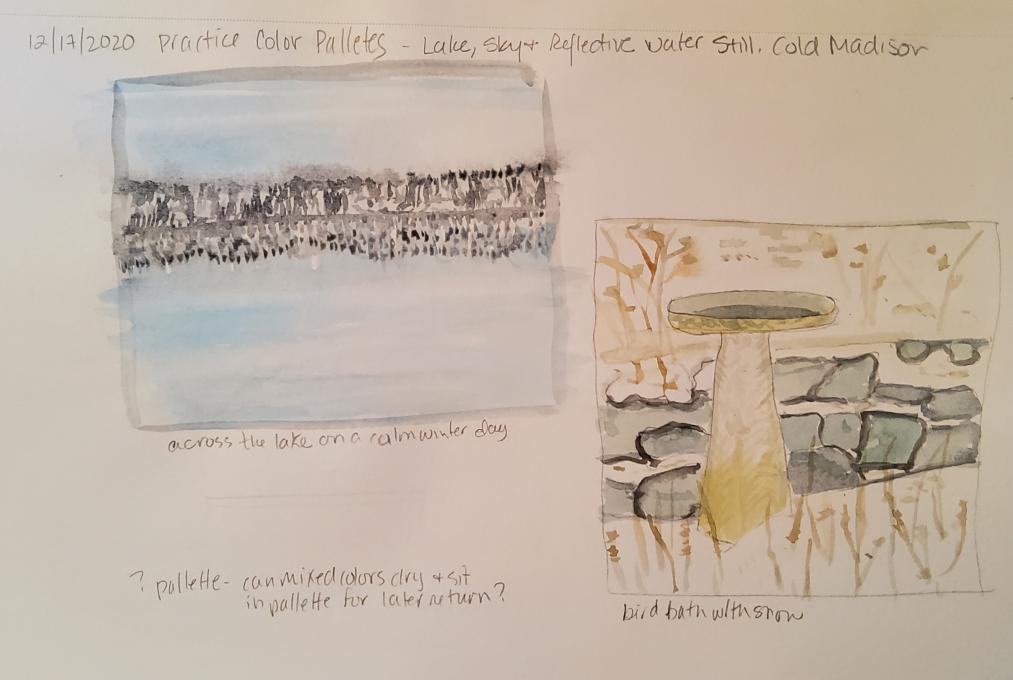 snow, water, and sky using wet on wet.
snow, water, and sky using wet on wet. 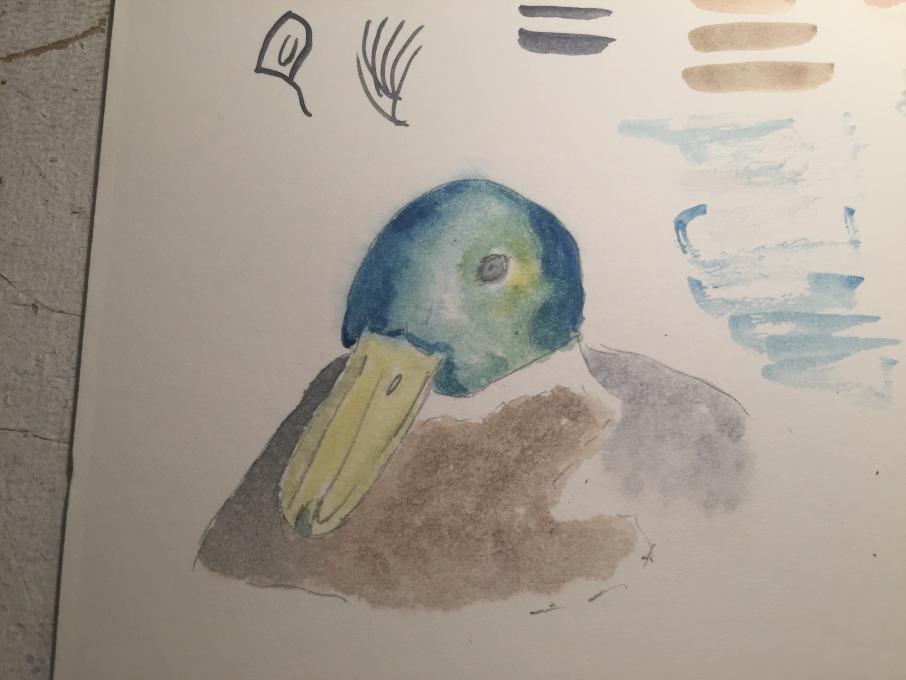
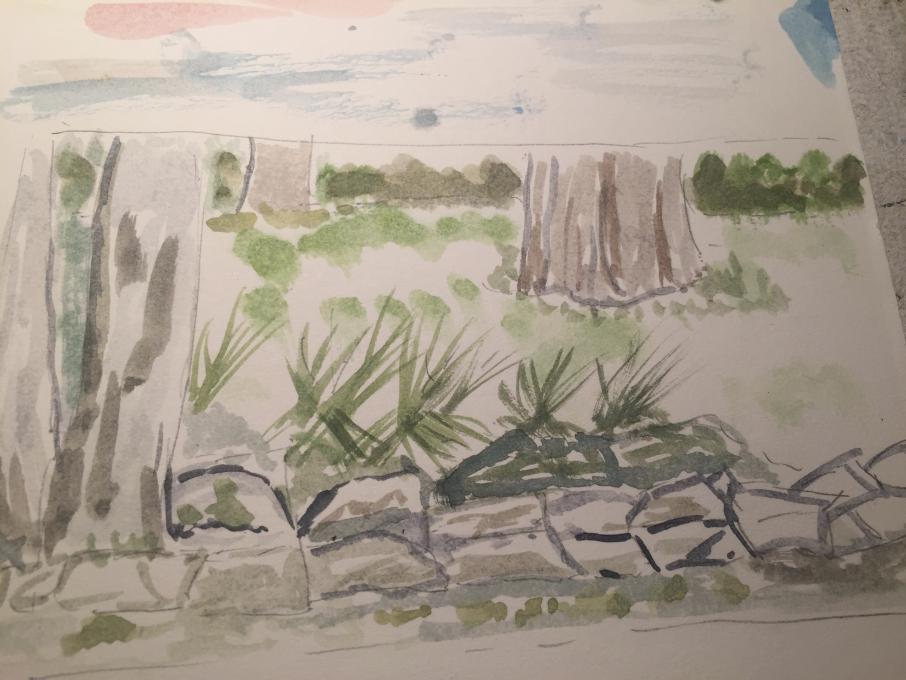


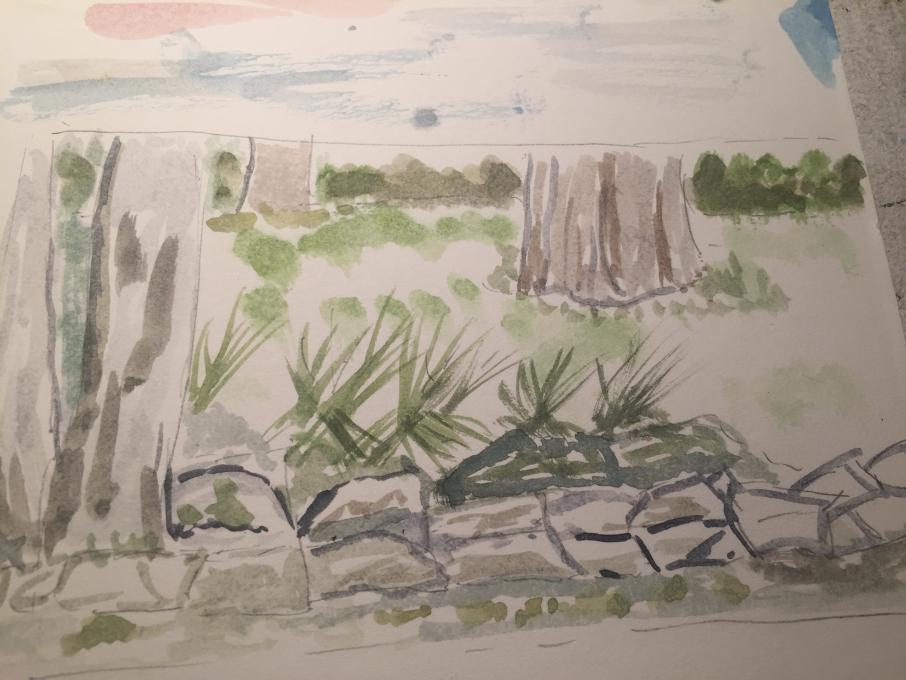
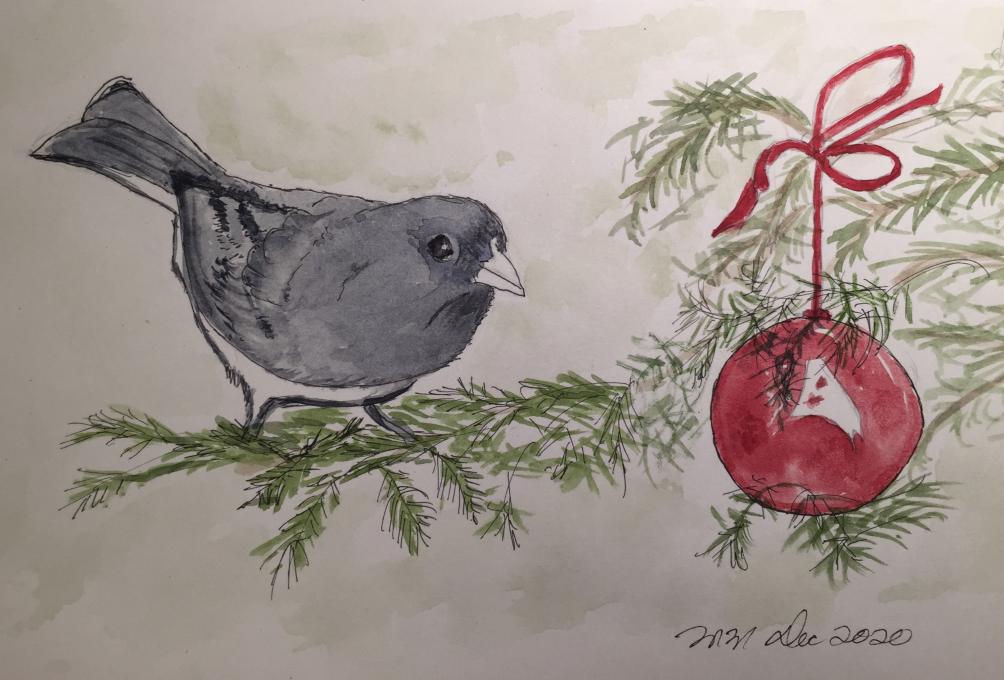

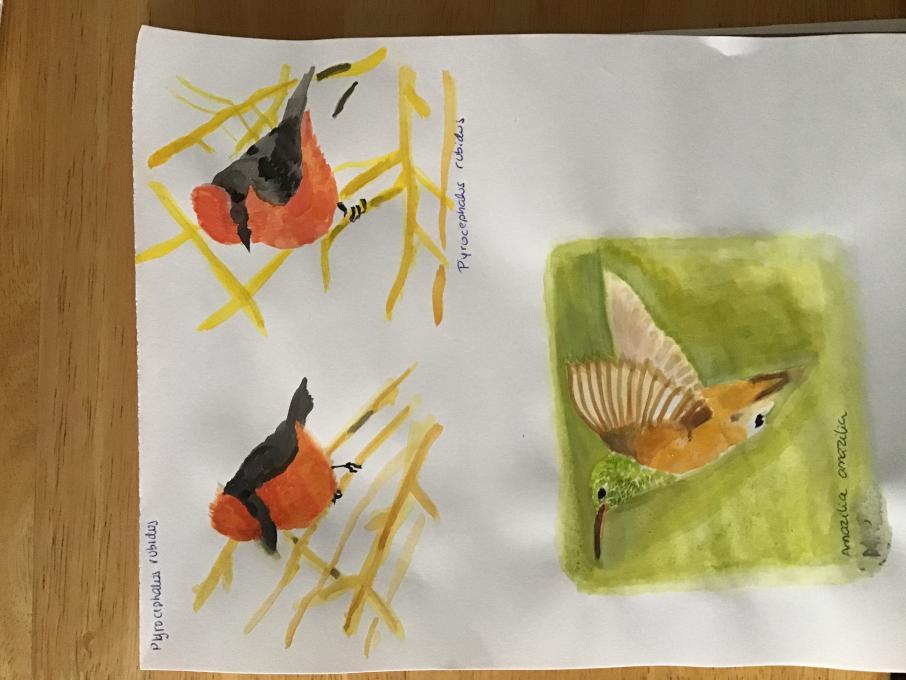
 This is what I did to try out the different techniques. Very difficult to regulate the amount of water on the brush. Took a while to get the hang of it. Still need practice but feel a little better about it
This is what I did to try out the different techniques. Very difficult to regulate the amount of water on the brush. Took a while to get the hang of it. Still need practice but feel a little better about it  </p>
</p>  I used the wet on dry technique on the bird and many paint layers. I tried the wet on wet technique on the sky and grass but it is very difficult.
I used the wet on dry technique on the bird and many paint layers. I tried the wet on wet technique on the sky and grass but it is very difficult.  and then wet on wet with the golden light behind.
Also I layered many various colors in the feathers, especially back of neck area.
and then wet on wet with the golden light behind.
Also I layered many various colors in the feathers, especially back of neck area. 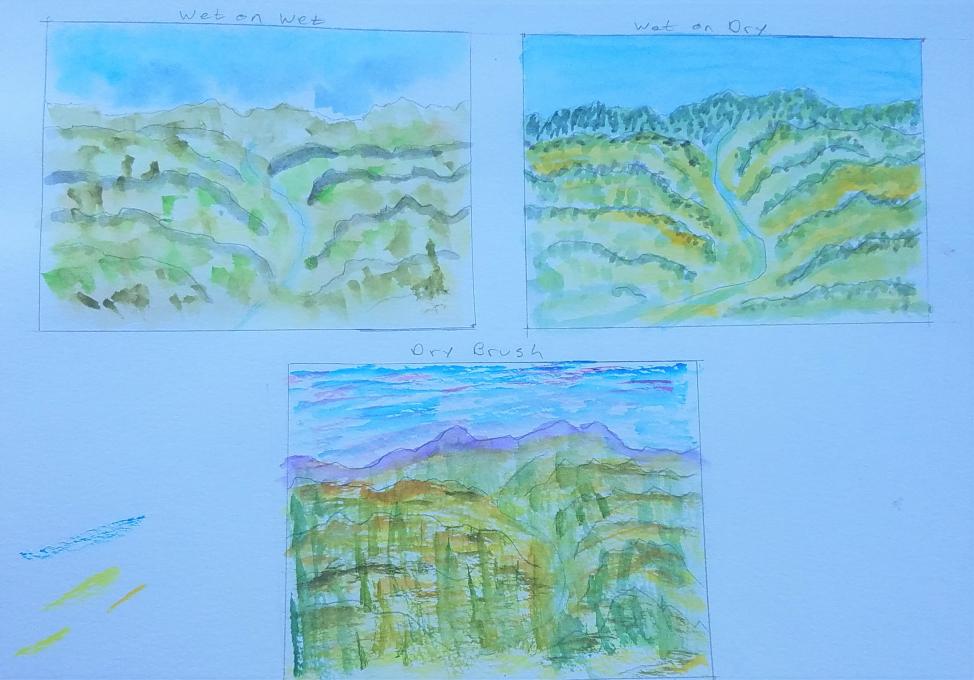


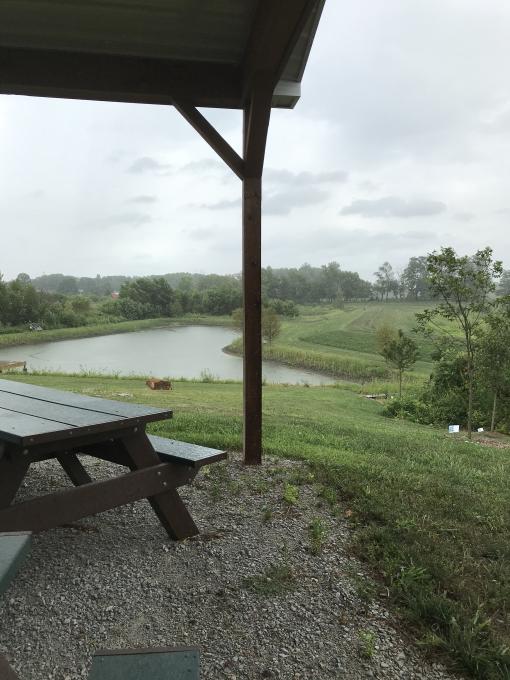
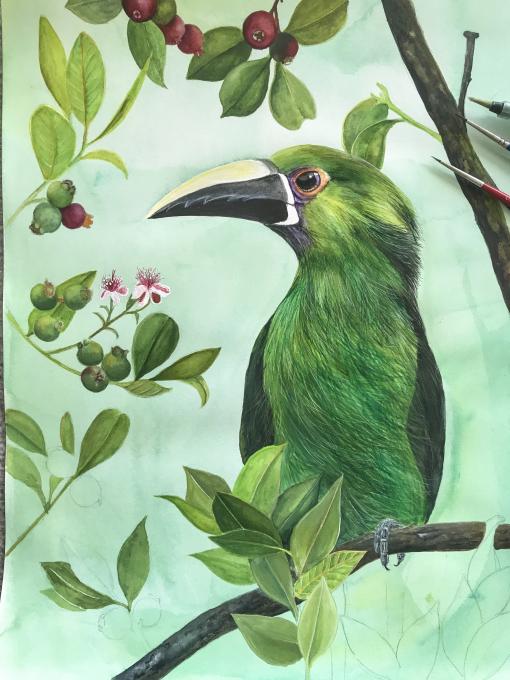


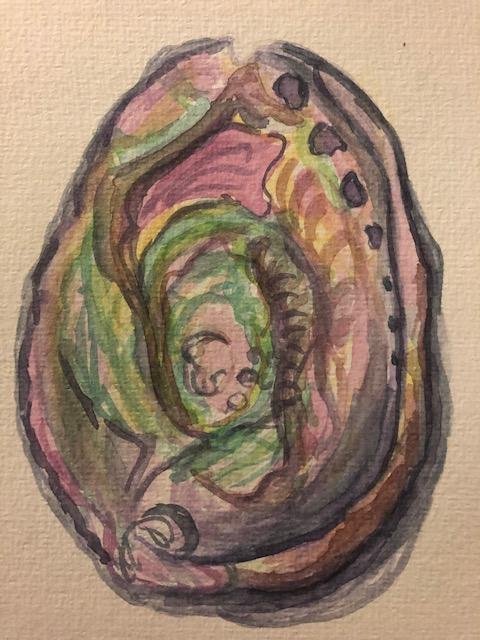 I have tried all 3 techniques. Dry brush as you can see on the abalone seem to come off to harsh or too bold. I found patience is key and waiting for the paint to dry before muddling up the painting. I love water and lightness of pigment in creating skies.
I have tried all 3 techniques. Dry brush as you can see on the abalone seem to come off to harsh or too bold. I found patience is key and waiting for the paint to dry before muddling up the painting. I love water and lightness of pigment in creating skies.  The sky, water, and trees were first wet on wet with some wet brush on top once the paper had dried. The fence was from a dry brush. The grass was wet on dry.
The sky, water, and trees were first wet on wet with some wet brush on top once the paper had dried. The fence was from a dry brush. The grass was wet on dry.